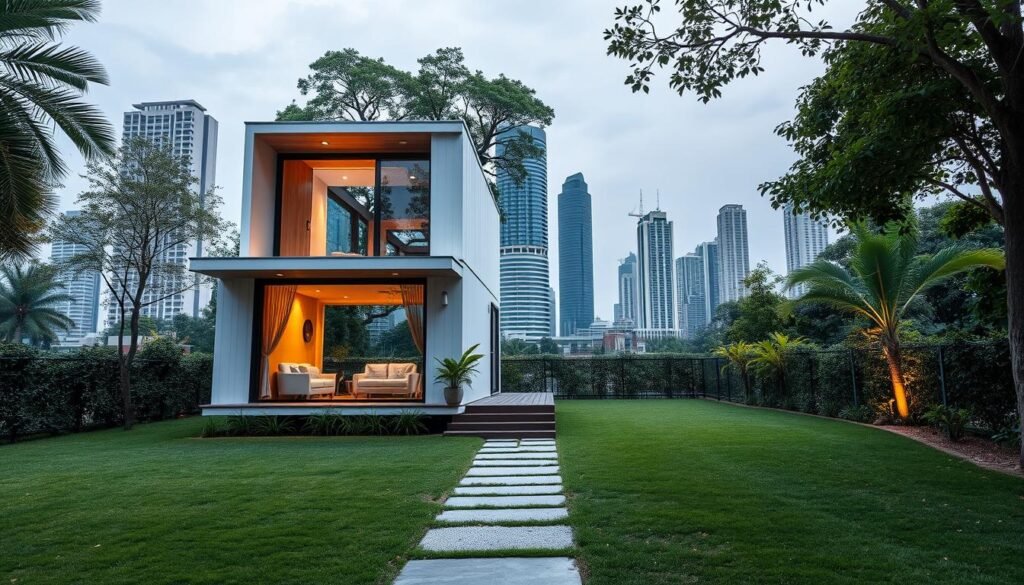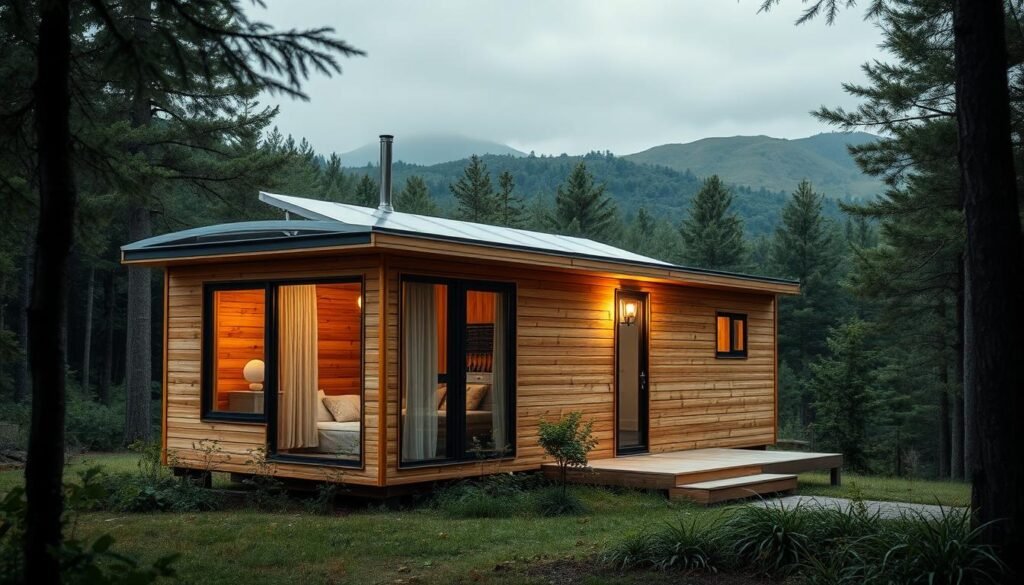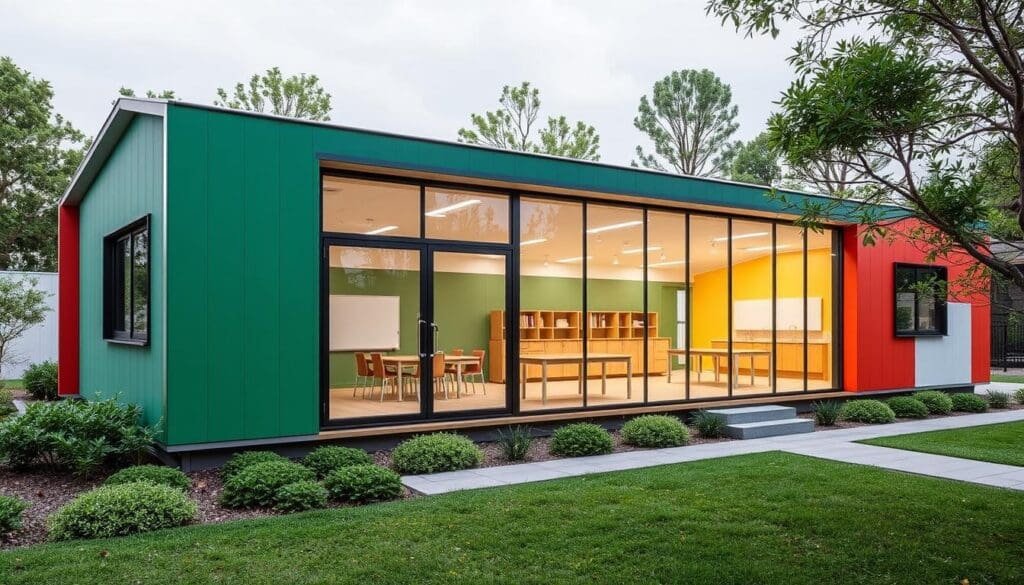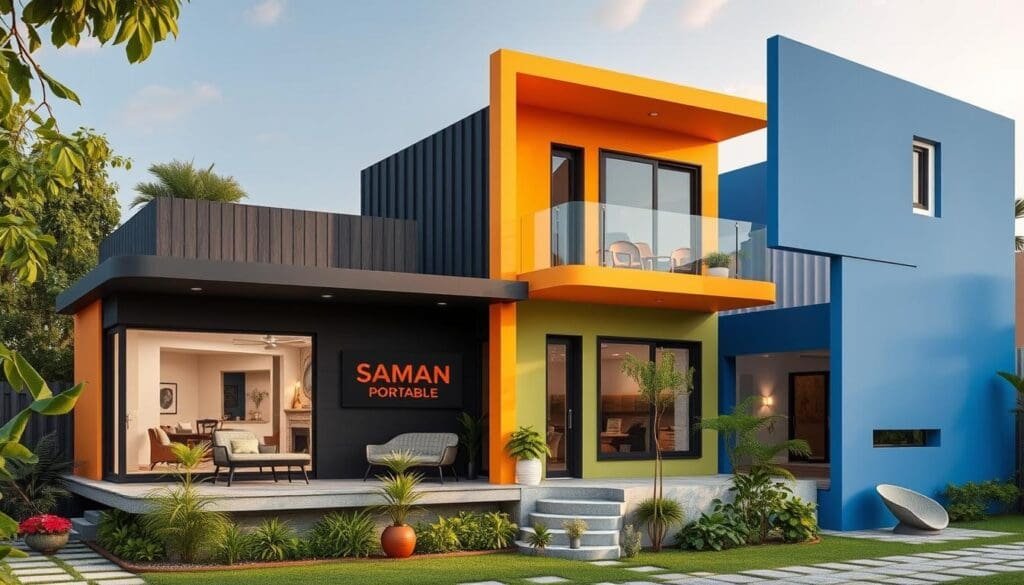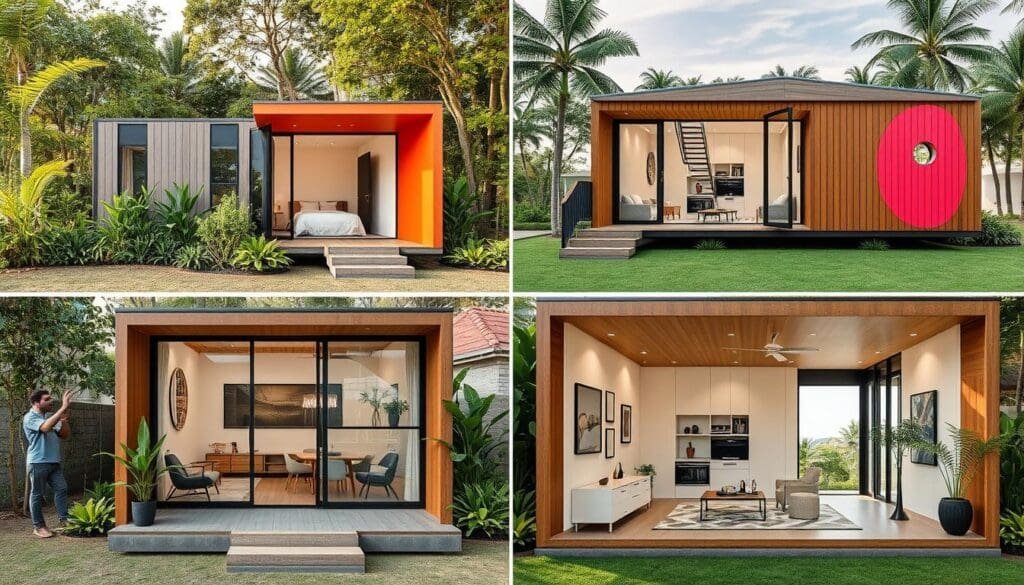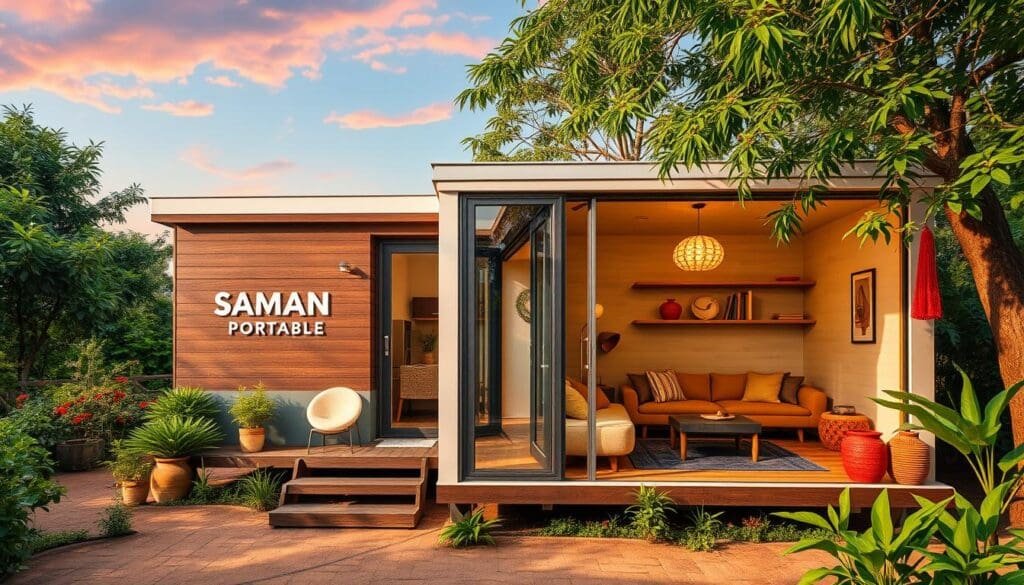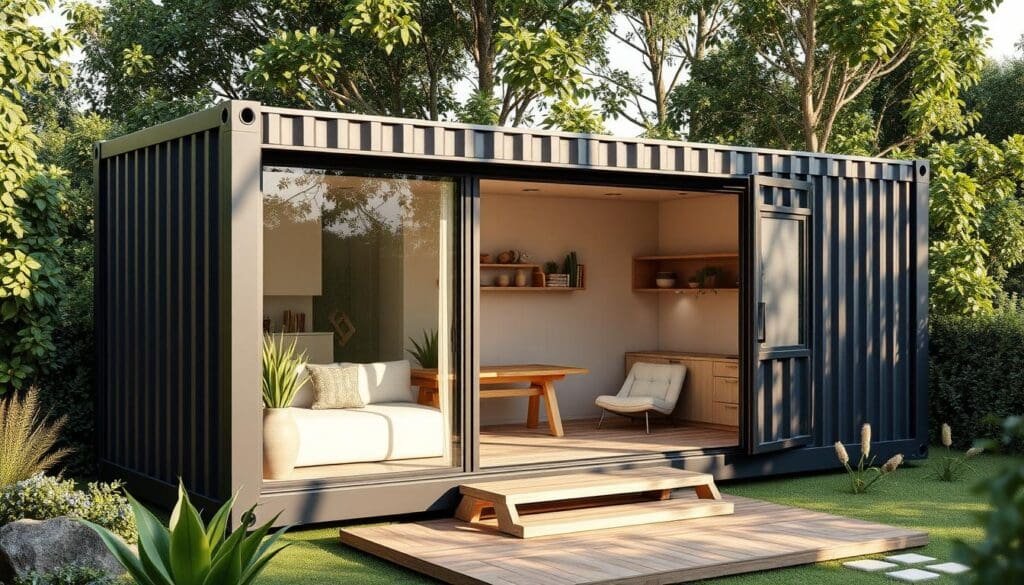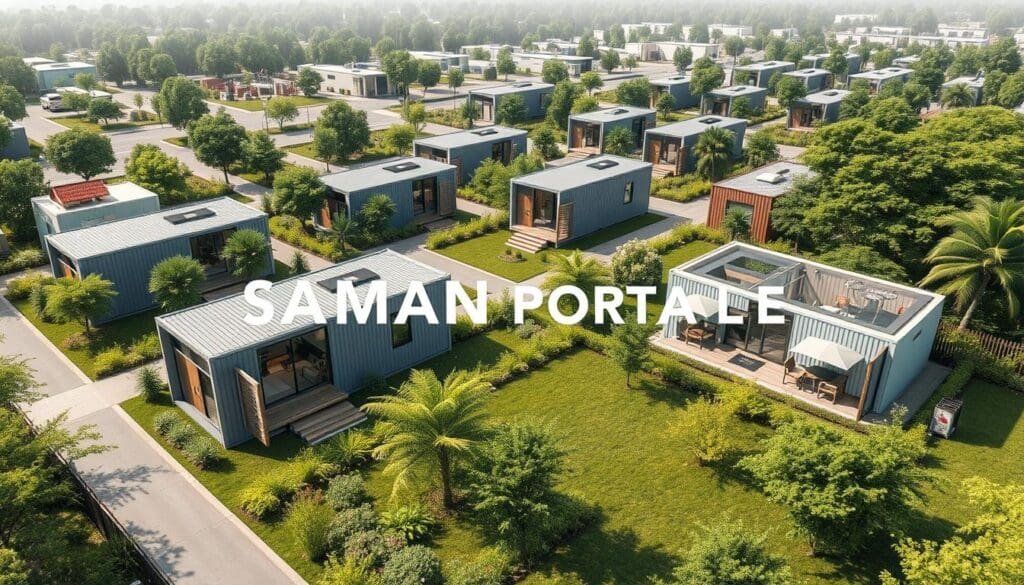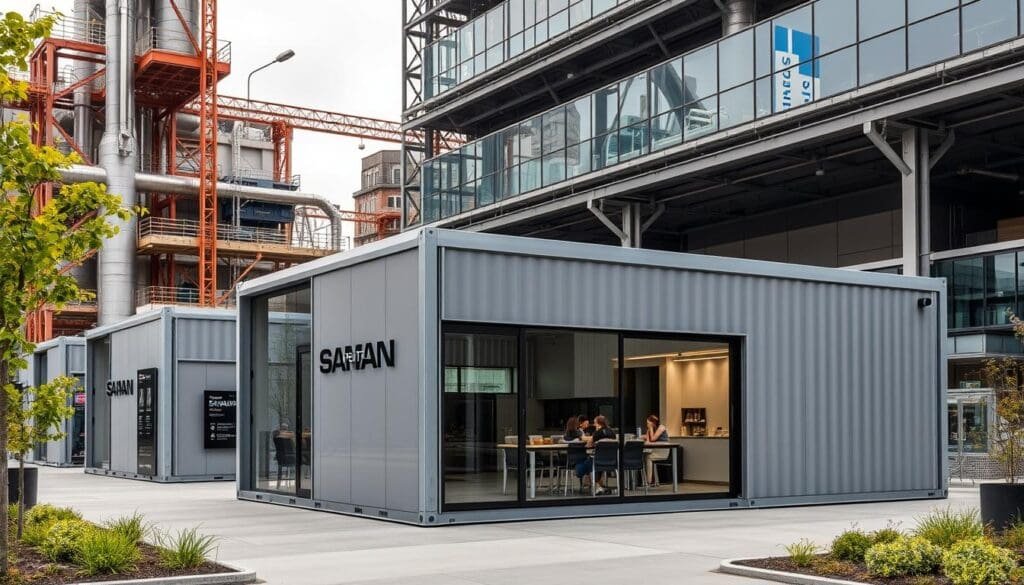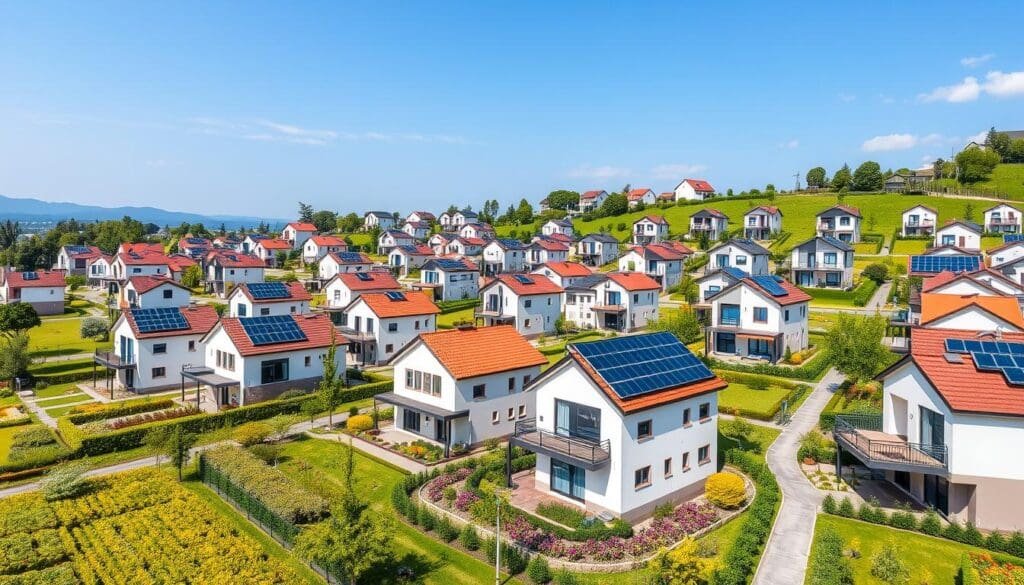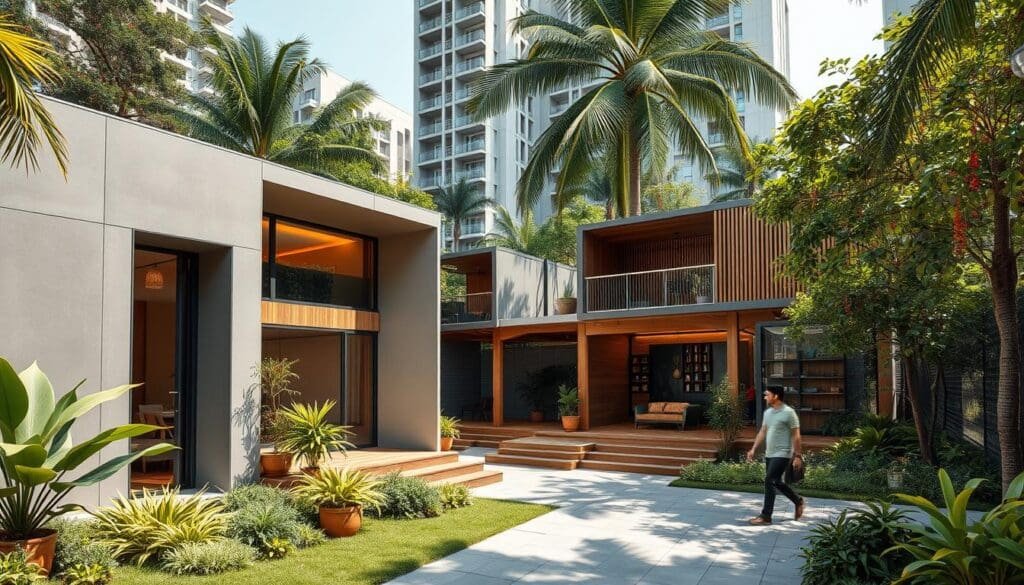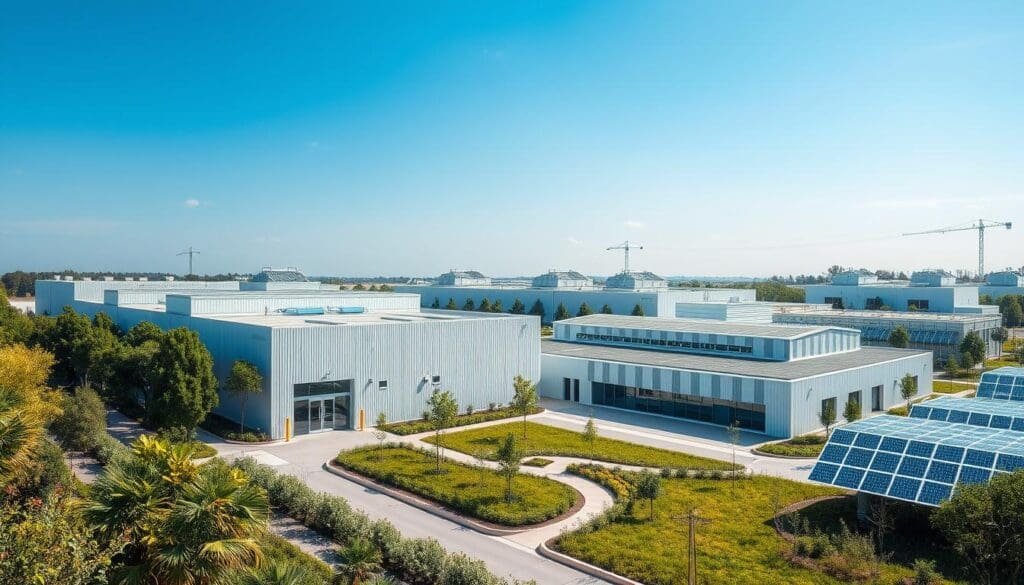Sustainable Architecture Trends: From Container Homes to Portable Offices
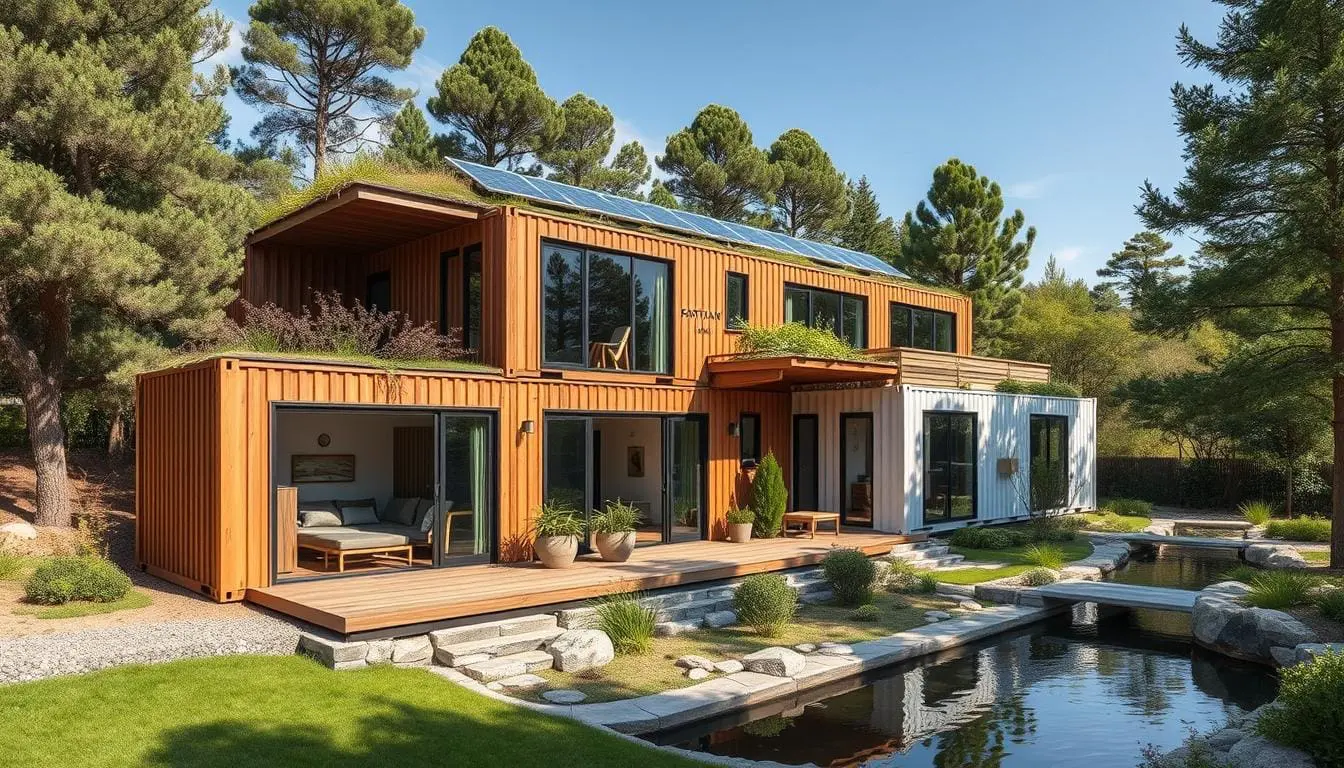
In the world of architecture, a new trend is changing how we build: using shipping containers. These containers are now homes and offices, making our spaces more sustainable. But why are they important, and how do they help our planet? Let’s dive into the world of container architecture to find out.
Key Takeaways
- Shipping containers are being repurposed as a sustainable and cost-effective building material for homes and offices.
- Container-based structures offer benefits like energy efficiency, durability, and reduced environmental impact.
- The trend of container architecture is driven by the need for affordable housing and the push for more sustainable construction practices.
- Architects are designing innovative container-based structures that cater to diverse climates and user requirements.
- Container homes and portable offices are gaining popularity as they provide a flexible and adaptable solution to modern space challenges.
The Evolution of Container Architecture
Container architecture has changed a lot, turning old shipping containers into new homes. This trend is spreading worldwide, showing a green way to build houses.
Origins and Global Adoption
Shipping containers were made for moving goods. Now, they’re used to build homes and offices. Countries like India are really into this idea.
From Shipping Containers to Living Spaces
Turning containers into homes has changed the housing world. These strong, green homes are made from old containers. Shipping containers can be stacked up to 12 units high when empty and a 12-meters long shipping container weighs over 3,500 kilograms (7,700 lbs).
The Rise of Modular Construction
Modular construction has made container homes even better. It lets builders quickly make homes in many styles. The roof of a 20 feet long container is tested to withstand a 300 kilograms (660 lbs) load, and a shipping container structure exceeding 40 feet in length may face inefficiencies in time and money during construction.
Turning shipping containers into homes has changed the game. It’s a green, flexible way to build. This idea is loved worldwide, leading to a greener future in building.

Understanding Container Homes: A Modern Housing Solution
Container homes are a new way to live, blending eco-friendliness, affordability, and flexibility. They use old shipping containers to build homes, helping our planet. This idea is becoming popular all over the world.
In India, people are really interested in these homes. They are cheap, quick to build, and can be made to fit your needs. This makes living sustainably easier for more people.
Container homes have many benefits. They cost between $10,000 to $50,000 to make, with fancy ones costing more. Building one can take a few weeks to months, depending on how complex it is. They also use green tech like solar panels and collect rainwater, which is good for the environment.
Keeping the inside of these homes comfortable is key. They need good insulation to stay cool in summer and warm in winter. Making changes, like adding doors and windows, needs experts to avoid problems.

Container homes are special because you can design them in many ways. You can have a simple one or a big, multi-story house. They are also good for the planet because they reuse old containers.
But, there are some hurdles like dealing with local rules and codes. Despite this, their green benefits, cost, and design freedom make them a great choice for homes today. As more people want to live sustainably, container homes will become even more important in building design.
The Economics of Container Construction
Shipping containers are changing the game in modern architecture. They offer a cost-effective way to build homes that are both affordable and eco-friendly. This makes them a great choice for those looking for a budget-friendly, green living space.
Cost Comparison with Traditional Buildings
Container houses are often cheaper than traditional houses, costing under $50,000. This is because they use recycled shipping containers, saving on materials. Plus, their modular design makes building faster and cheaper, cutting down on labor costs.
Investment and Return Analysis
Container homes are a smart financial choice in the long run. Investment and return analysis shows they save money over time. They use less energy and need less upkeep. Plus, they can be built quickly, saving on labor costs and getting you moved in faster.
Long-term Financial Benefits
- Reduced material and labor costs for construction
- Lower energy bills due to energy-efficient design
- Minimal maintenance requirements
- Faster construction timeline leading to quicker occupancy
The container construction economics are strong. They offer a smart choice for cost-effective housing. This makes them a top pick for investment analysis and building sustainable communities.

Portable Offices: Revolutionizing Workspace Design
The modern business world is changing fast, thanks to portable offices, like porta cabins and container offices. These new structures are changing how companies design their workspaces. They offer flexibility, mobility, and are good for the environment.
Portable offices are a smart choice for businesses looking for a temporary or permanent space. They can be set up quickly and moved easily. This makes them perfect for construction sites, remote areas, or growing companies. They let businesses design their space to fit their needs, saving space and resources.
Portable offices also help make businesses more eco-friendly. They use green materials and save energy, which is better for the planet. By choosing portable offices, companies show they care about the environment and work better.
The growth of portable offices has led to new ideas in workspace design. Now, we see more modular furniture, smart tech, and designs that are good for your body. Portable offices are all about being flexible and meeting the needs of today’s workers.
The need for flexible and green workspaces is only getting bigger. The portable office industry is at the forefront of this change. They offer cost savings, easy setup, and care for the planet. These structures are shaping the future of workspaces.

Sustainable Architecture: Principles and Practices
Sustainable architecture in container homes is a complete approach. It includes energy efficiency, eco-friendly materials, and waste reduction. These steps help make container structures less harmful to the environment and support a greener future.
Energy Efficiency Features
Container homes use better insulation, natural light, and ventilation systems. In Victoria, buildings must meet a 6 Star energy rating. Homes rated 7.5 Stars and up are even more energy-efficient.
These features cut down on energy use. This means less carbon emissions from the buildings.
Eco-friendly Materials
Using recycled, recyclable, and green materials is key in sustainable architecture. This method reduces waste and saves natural resources. It also helps lower a building’s carbon footprint.
Waste Reduction Strategies
Container architecture is all about reducing waste by using old shipping containers. It also aims to cut down on construction waste. These efforts help create a more circular economy and lessen environmental impact.
By following these principles, container homes become more energy-efficient, eco-friendly, and waste-conscious. This leads to a more sustainable future.

| Feature | Description |
|---|---|
| Thermal Comfort | Sustainable architecture promotes thermal comfort through efficient insulation and ventilation, ensuring a comfortable living environment. |
| Natural Light | Sustainable design maximizes natural light to reduce the need for artificial lighting, enhancing energy efficiency and well-being. |
| Air Quality | Sustainable architecture prioritizes good air quality, using natural ventilation and air-purifying materials to maintain a healthy indoor environment. |
| Connection to Nature | Sustainable container homes strive to create a harmonious connection between the built environment and the surrounding natural landscape. |
Design Innovation in Container Spaces
The world of architecture is changing fast. Now, industrial shipping containers are being turned into cool living and working spaces. Architects and designers are mixing industrial looks with modern needs to make amazing container spaces.
They’re combining creativity with engineering to meet the need for green and flexible homes and offices. This shows how we can use old materials in new ways.
The Crossbox House is a great example. It’s made from four 40-foot containers and has 112 square meters of space. It shows how container design can be used to create modern space planning without losing style or comfort.
Worldwide, more projects like this are popping up. The Puma City pop-up shop is huge, at 11,000 square feet, and made from containers. The Container Guest House is a 640 square foot home from just one container. These projects show the endless possibilities of container design for affordable, green, and flexible buildings.
But it’s not just homes. The sales office for Silverbay luxury homes was built from four containers. This shows container design is good for business too. It’s green and can be changed or moved easily.
| Project | Container Usage | Highlights |
|---|---|---|
| Crossbox House | 4 x 40-foot cubic cargo containers | 112 square meter property with integrated living and working areas |
| Puma City Pop-up Shop | Repurposed shipping containers | 11,000 square feet of retail space |
| Container Guest House | Single shipping container | 640 square foot guest house |
| Silverbay Sales Office | 4 shipping containers | Cost-effective, sustainable, and semi-permanent workspace solution |
These projects show how far we can go with industrial materials. By mixing space planning and innovative architecture, we’re making amazing places to live and work. They’re not just green and flexible, but also redefine what modern spaces should be.

Environmental Impact and Benefits
Sustainable architecture, like container homes, brings big environmental wins. They use old shipping containers, cutting down on new materials needed. This means less waste and less harm to our planet. Plus, adding solar panels and wind turbines makes them even greener.
Carbon Footprint Reduction
The environmental impact of container homes is huge for cutting down carbon. Buildings and construction use a lot of energy and cause a lot of CO2 emissions. Using shipping containers makes homes more eco-friendly, helping us move towards a greener future.
Resource Conservation
Container homes are also great at saving resources. They use space well and choose sustainable materials. This means we need less from nature. Living in a container home encourages us to use resources wisely, helping the planet.
Waste Management Solutions
Container homes also help with waste. They turn old shipping containers into homes, keeping waste out of landfills. Their design makes it easy to add systems for recycling and managing waste.
In short, container homes are a big win for the environment. They show how design can help solve big global problems. As we look for ways to live greener, container homes are a leading example of how to do it right.
Adapting Containers for Different Climates
The world is moving towards sustainable architecture, and shipping containers are key. In places like India, where the weather is extreme, keeping buildings cool or warm is essential. This is crucial for comfort and saving energy in container homes.
Containers can get hot or cold easily because they conduct heat well. Spray foam insulation and new ways to insulate are used to fix this. But, the industry is also looking for eco-friendly insulation materials to protect health.
- Using over 17 million old shipping containers can cut down energy use a lot. This saves 46 tons of CO2 emissions in Canada.
- Container houses have a lower carbon footprint than houses made of wood or concrete.
- Using a 20-inch container instead of concrete saves 12 tons of CO2 over its life.
By adapting to the climate, container homes stay comfortable and save energy. This makes them a smart choice for homes and workspaces today.

Smart Technology Integration in Container Structures
Container architecture has evolved, introducing smart technology. This has made these structures more functional and efficient. Now, container homes and offices use intelligent systems for better sustainability and user experience.
Automation Systems
Automation in container structures controls lighting, temperature, and ventilation. These systems save energy and make living or working areas comfortable. They help control climate and air quality, cutting down on carbon emissions.
Energy Management Solutions
Container structures use smart energy solutions like solar panels and smart meters. Solar power integration cuts down on energy costs and boosts sustainability. Smart agricultural sensors in indoor farming improve growing conditions, leading to higher yields.
Security Features
Container structures have smart security features like automated locks and surveillance. These features offer protection and remote monitoring. They ensure occupants’ safety and peace of mind.
The use of smart technology in container structures makes them versatile, energy-efficient, and secure. Companies like Arabian Containers lead in creating smart container homes and offices in the UAE. They set high standards for sustainable and advanced modular construction.
Legal Considerations and Building Codes
Building container homes in India means you must follow strict building codes and zoning laws. These rules are key to making sure your home is safe and well-built.
The National Building Code (NBC) of India gives detailed rules for choosing a site, designing structures, and ensuring fire and plumbing safety. Also, local areas have their own rules about where you can build and how far apart buildings must be.
It’s important to add fire safety features like fireproof materials and clear exit paths. Following the Indian Electricity Rules is also crucial for safe electrical systems. Using the Indian Green Building Council’s guidelines can help make your home eco-friendly.
Plumbing codes are important for installing water and waste systems correctly. This helps save water and manage waste properly. In areas that shake a lot, following seismic codes is key to keeping your home strong.
Dealing with all these rules can be tough. But it’s necessary for making container homes work in India. Getting the right permits and approvals is key to making sure your home is legal and safe.
| Regulation | Key Requirements |
|---|---|
| National Building Code (NBC) of India |
|
| Municipal Zoning Regulations |
|
| Indian Electricity Rules |
|
| Indian Green Building Council Guidelines |
|
| Seismic Codes |
|
Understanding building codes, zoning laws, and construction regulations is vital for container home success in India. By following these rules, your project can be safe, green, and meet local and national standards.

Customization Options and Interior Design
The container architecture movement is growing fast. Now, people focus more on making these homes look good and feel cozy. They want them to be as comfortable as regular houses, not just temporary or industrial.
Space Planning Strategies
Designing space in container homes is key. Architects and designers work hard to make the most of the small space. They use smart ideas like loft beds and built-in storage to make the most of every inch.
Material Selection
Choosing materials for container homes is all about lasting quality, being green, and looking good. Organic materials like wood, wool, and natural stone are popular for being eco-friendly. Even carpets made from ECONYL® yarn, made from recycled waste like fishing nets and plastics, are better for the planet than regular nylon ones.
Lighting Solutions
Lighting is very important in container homes. It makes the space feel welcoming and works well. Using windows and skylights lets in natural light, saving energy. Using lighter colors in rooms also helps reflect more light, needing less artificial lighting.
With these customization options, container homes can be both cozy and stylish. They challenge the idea that they’re just for temporary use. The focus on interior design, customization options, and space planning shows how container architecture is evolving. It’s becoming more about living well and being sustainable.

Maintenance and Longevity
Maintenance and longevity are key for container homes. The steel structure in shipping containers is strong. But, to keep container homes lasting, regular care is needed.
It’s important to check for rust, corrosion, and structural issues often. Also, keeping insulation and moisture control in check helps avoid damage. With the right care, container homes can last a long time, offering a green and lasting home option.
The construction world is facing a big worker shortage, with over 430,000 missing. This could lead to mistakes and delays. But, the industry is changing, using more recycled materials in construction.
Building with modules can be 50% quicker than traditional methods. This makes projects more efficient and strong. Also, more buildings are getting LEED-certified, showing a move towards greener construction.
- Regular maintenance is a must: Check your container home often for rust, corrosion, or structural problems. This keeps it strong for years.
- Keep insulation and moisture in check: Good insulation and moisture control stop condensation. This keeps your container home safe and sound.
- Choose sustainable building: Use recycled materials and modular methods. This makes your container home last longer and is better for the planet.
By focusing on maintenance and choosing green building, container homes can be a lasting and eco-friendly choice. They meet the need for strong and energy-saving homes.
Market Trends and Future Prospects
The market for container homes and offices is growing fast, especially in India. People are starting to see the value in using containers as homes and offices. They like how versatile and customizable these structures are.
Homeowners, developers, and architects are now using containers for different projects. This includes affordable housing and eco-friendly resorts. It’s a big change in how we think about building homes and offices.
The push for sustainable living is driving this growth. The container home market is getting bigger because of it. New technologies and designs are making containers more appealing for homes and offices.
Containers are now seen as a smart choice for saving energy and using eco-friendly materials. They also help reduce waste, making them a great option for those looking for affordable and green solutions.
In India, the need for affordable housing is on the rise. This is because more people are moving to cities. Architects and builders are using containers to offer affordable and green living and work spaces.
This is especially helpful for low-income communities. The entertainment industry in India is also growing. It’s creating a demand for architects who can design interiors and sets using containers.
FAQ
What are container homes?
Container homes are a new way to build houses using old shipping containers. They are cheaper, faster to build, and can be designed in many ways.
How are container homes built?
These homes are made from shipping containers used for sea travel. They are safe, sustainable, and can be moved anywhere. You can even stack them to make multi-story homes.
What are the advantages of container homes?
Container homes are good for the planet, affordable, and can be customized. They help reduce waste and save money. Plus, they are built quickly.
How do the costs of container homes compare to traditional buildings?
Building with containers is cheaper than traditional houses. It saves money on materials and labor. Plus, you can move in faster.
What are portable offices, and how do they benefit businesses?
Portable office cabins, like porta cabins and container offices, change how we work. They are flexible, mobile, and green. They offer affordable solutions for any workspace needs.
How do container homes address sustainability and environmental concerns?
Container homes are built to be green. They use energy wisely, choose eco-friendly materials, and reduce waste. This helps the planet and saves energy.
How do designers and architects innovate with container spaces?
Designers make the most of small spaces in containers. They find creative ways to make these spaces stylish and functional. It’s all about using space well.
What are the legal and regulatory considerations for container homes?
It’s important to follow local building rules for container homes. This ensures they are safe and well-built. Getting the right permits is key to success.
How can container homes be customized and designed for interior comfort?
Customizing container homes is all about planning and design. Choosing the right materials and lighting makes them cozy and stylish. They can feel just like a traditional house.
How can container homes and offices be maintained for long-term use?
Keeping container homes in good shape is important. Regular checks, fixing insulation, and taking care of them helps them last a long time. They are built to last.
What are the market trends and future prospects for container homes and offices?
The demand for container homes and offices is growing. They are becoming more popular in India and worldwide. As design and technology improve, their future looks bright.
 Container Cafe
Container Cafe
















































































